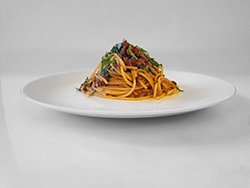
There’s no point in displaying any false modesty about spaghetti al ragù all’inglese for two reasons. First of all, it was absolutely amazing. Second, it was a natural evolution of what came before it.
When you build a recipe for yourself it should match your every desire. There were so many things about this dish that tipped it towards my little corner of perfection that it’s difficult to know where to start. I’ll kick off with the meat base.
I didn’t think I had anything to learn about soffritto but how wrong I was. That Sat Bains knows his onions. And carrots. And celery. I built each component up, as suggested, eliminating every last drop of moisture. The soffritto alone took over an hour to nurture but gave me early confidence I was on to a good thing. The carrots in particular impressed.
I never expected the humble root vegetable could surprise me, but after such a long and dry cook the aromas released were revelatory. The dry heat and a mild mineraly smell made me picture a Swedish sauna. Towards the end of cooking, the deep orange chunks developed a flavour halfway between earthy and caramelised.
The onions and celery didn’t quite play this dry heat game with the same enthusiasm, and were noticeably struggling in patches, but this just added to the depth of flavour.
When the soffritto was mixed with the nicely reduced and acidic white wine, then combined with mashed bone marrow and pork brodo, I could have walked away and declared this sugo a vintage. However, things continued to improve from there.
After 48 hours of sous viding across two batches of stewing meats in the aforementioned sugo, I was ready for a halftime taste. Each of the meats added a different complexion to the sauce. The oxtail provided a gaminess, the shin and ox cheek more meatiness. When mixed together the balance was perfect, similar to the mild gaminess of l’Accademia’s cartelo di manzo bolognese, but with the volume turned up.
The sauce was reduced whilst the meat was cut into small pieces. After separating oxtail meat from the bones, the constituent parts of the meat base were reunited. The resultant mix was incredibly rich, with a very low water content and had almost all the flavour I expected. One thing was missing, however. The fat content was too low.
I was just about to reach for butter, the classic French meat-velvetiser, but was instead drawn to the block of pork lardo I’d had in the fridge since Alvisi’s ragù. The fat was finely sliced and mezzaluna’d, before being rendered and added to my meat base.
This turned out to be quite an eye opener. Spaghetti bolognesi’s high pork content made for a dish that was just lacking something. I knew I preferred l’Accademia’s bolognese but wasn’t completely sure why. It turns out it comes down to the meat, but not the fat. Cow meat being dominated by pig meat makes for an austere taste. Cow meat complemented by pig fat, on the other hand, tastes as decadent as it gets.
This revelation, discovered more by luck than judgement, ends up defining the meat base for ragù all’inglese. I’m not sure to what extent the lardo makes this the case over plain old lard, but after such an epic cook I wouldn’t want to take the chance. The meat base had a butteriness, which could have come from the bone marrow, but I would hazard a guess the lardo also played its part.
The tomato compote was equally interesting. Heston Blumenthal’s pressure cooked tomatoes were intensely powerful in flavour. When mixed with the onion, pancetta, butter, anchovies and citric acid the result was an incredibly fruity tomato taste. For me, it had all the punch of Blumenthal’s compote, but without the overpowering flavours that confused the palate. This mix was Dolmio on steroids.
The rapeseed oil was a late addition and paid dividends. The oil has almost no flavour, but with an increased fat content, the sauce was allowed to boil away ever further, leaving a compote closer to a dressing than a sauce. The healthy chunks of dehydrated tomato flesh brought the compote back to a Napoletana-style taste and texture, but swimming in a luxurious flavour.
Finally, our beef Harami had its moment to shine. Three hours in the sous vide followed by three minutes under the blowtorch, gave the meat a soft and charred texture. The meat was finely sliced and worked perfectly with the tomatoes. It gave the sauce a taste and texture like Tom Kerridge’s roasted beef mince, but with a more refined finish.
My original aim was to produce a meat base and a tomato compote that could stand alone, and my first taste was through a giant pile of spaghetti, blended from meat to tomato. I wanted to understand this flavour across the sauce spectrum. In the final preparation, I added the spice mix to the spaghetti and gave it a good stir. Added coriander to the meat base and basil and parmesan to the compote.
Starting with the meat base the taste was just as I had expected. Very strong flavours of beef, but with a good balance of gaminess from the oxtail and butteriness from somewhere - either the pork lardo or the bone marrow. There was a slight sharpness from the sauce which I assumed I could attribute to the white wine, and this was a welcome relief for such a meaty meal.
The coriander worked wonders, another component that gave a slight twist away from tasting too much like a meat stew. The spice mix also played its part. This is probably the first time ever I hadn’t over-spiced a dish. The heat was very low on the first bite but gently built up as a long note for the dish, giving the taste a grandstand finish.
Distributing the chilli evenly was clearly a challenge as you would occasionally get a strong hit of chilli (both heat and flavour) from the very powerful Bhut Jolokia. I considered this to make for an interesting twist and one I welcomed. Distributing these little flavour bombs throughout the sauce might make for an interesting next step.
Up next was the compote and as expected a very different taste. The combination of fruity tomatoes and musty harami was incredible. The tomato flesh really helped distribute flavours, and no two bites were exactly the same. Some mouthfuls gave me more freshness from the tomatoes, others a more meaty flavour. The occasional charred chunk of harami was a real highlight and a taste I would look to harness more of next time. The basil gave the finished product an “Italianness”, at least through an Englishman’s taste buds.
So the first outing was a success, but gave me a couple of things to consider. There was some slight room for improvement. My meat base was slightly underseasoned, I could do with a little more of the pork lardo, and a touch more spice mix. All this was easily resolved. I also opted to ditch the homemade spaghetti.
I had a nagging doubt about the spaghetti throughout my testing. For me, part of the appeal of spaghetti over tagliatelle is the al dente texture. I wasn’t able to achieve the same texture with homemade spaghetti. As the egg based dough was left to slowly dry, it would become crumbly rather than firm. I may just need to get better at making pasta, but decided to park this and go for a packet of the dried stuff for comparison.
I was now ready to combine meat and compote into a single sugo.
The end result was outstanding!
This was the taste of spaghetti al ragù all’inglese I was longing for. Perfectly balanced between the meat base and tomato compote. Deeply meaty and tart. Herby and spicy hot. Lacking any moisture but not being dry. The reassuring bite of al dente spaghetti.
The combination really is the food of the gods!
You do pay a slight price when the flavours are combined. Some of the subtleties fade into the ambience of the dish. It’s not to say they don’t contribute, but they are less noticeable. Coriander was vitally important to balance the meat base, but becomes quite hard to pick out. The individual taste of the harami mostly goes too, though the change in texture can be picked out.
Is there anything I would change about spaghetti al ragù all’inglese? Possibly. There’s a couple of candidates I would at least like to explore.
First was the meat. I’d followed Bottura’s advice to keep the sous vide at 63 degrees for 24 hours for the beef cheek but uped the temperature to a more traditional 80 degree braising temparature for the shin and oxtail. 63 degrees is a very low heat for a cut like beef cheek. The cheek came out rather “firm”.
You can only assume Bottura knows exactly what he’s doing. The outcome is a meat that is slightly on the tougher side and presumably that’s why he also recommends finely slicing with a knife. When it works, it is brilliant. The meat has a slight bite to it but is already small enough for no further chewing to be required. Occasionally, however, you get a slightly bigger chunk which managed to escape the fine slicing. It’s not unpleasant, but certainly not as perfect as the very finely sliced meats.
The remedy is to either sous vide the beef cheek on a higher temperature, or be military in the precision of your meat slicing. I’d like to understand which version is more suited to my palate. I would naturally favour a softer meat with pasta, but using firmer meat could be one of those subtle, eye opening techniques you learn from top chefs. Either way, I would take a little more care over the final meat slicing stage.
My second potential change would be the addition of star anise to the meat base. You may have heard Blumenthal talk about star anise as a meat enhancer. His theory is that if you add a little to any dish with rich meats, you get an even richer meaty flavour without being able to taste the star anise. I think he’s wrong. I’ve added star anise to many a meat dish and can always pick it out from a mile away. It is a great combination though and potentially does have a place in spaghetti al ragù all’inglese.
I’d previously said I was well acquainted with Blumenthal’s bolognese, and star anise is a big part of that flavour. Arguably, Blumenthal’s was the first spaghetti al ragù all’inglese recipe, he just gave it the wrong name. Maybe to make the dish properly, star anise is one of the vital ingredients which adds to the flavour. I will certainly be giving it a go for the next outing.
All in all, I was extremely satisfied with my new dish. Up to this point my favourite ragù had been l’Accademia’s, but the mantle has definitely been passed to spaghetti al ragù all’inglese.
If you’ve learned anything on this journey, it should be that any dish will evolve and this evolution should be welcomed. I sincerely look forward to the next iteration in the bolognese story.
Italy: the ball is in your court!
